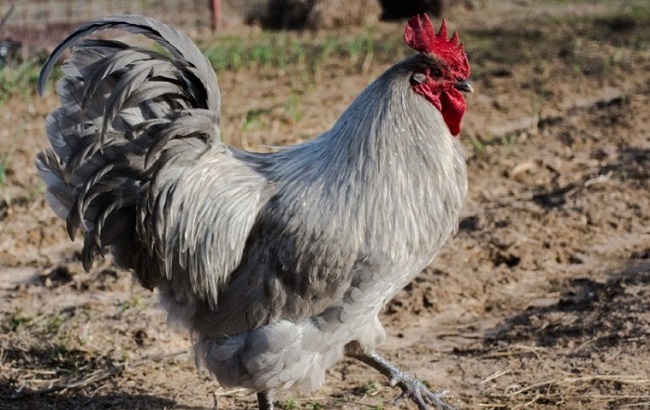The world of chicken breeds is incredibly diverse, featuring varieties of all sizes, colors, and purposes. For those seeking larger birds, whether for meat production, egg-laying, or simply for their majestic appearance, a number of breeds fit the bill.
This guide will delve into the captivating world of large chicken breeds, shedding light on their unique characteristics, benefits, and the care they require.

Some Interesting Large Chicken Breeds
Here are some of the large chicken breeds:
Read Also:
Jersey Giant: The True Giant Among Chickens
The Jersey Giant truly lives up to its name. Developed in New Jersey in the late 19th century, this breed is the largest purebred chicken, with mature roosters weighing up to 15 pounds.
Known for their calm and gentle demeanor, Jersey Giants are not only great meat birds but also reliable layers of large brown eggs.
Brahma: The Majestic Beauty
Brahmas are another large breed, often weighing between 10 to 12 pounds. Known for their size and striking appearance, Brahmas are a favorite among poultry enthusiasts.
They’re resilient to cold weather thanks to their feather-covered feet and produce medium-sized brown eggs consistently.
Orpington: A Gentle Giant
Orpingtons are popular large chickens, primarily known for their docile nature and excellent egg-laying abilities. Typically weighing between 7-10 pounds, Orpingtons are not only substantial in size but also reliable layers, producing large brown eggs.
Cochin: A Feathered Wonder
Cochins, with their unique feathered legs and rounded body shape, are one of the more visually striking large chicken breeds. These gentle and friendly birds weigh around 8-10 pounds and lay a fair amount of medium-sized brown eggs.
Cornish Cross: A Meat Producer’s Dream
For those specifically interested in meat production, the Cornish Cross is an excellent choice. While not a pure breed but a hybrid, this bird grows rapidly and can reach a hefty weight of 10 pounds in just 6 to 8 weeks.
They are the industry standard for commercial meat production due to their size and growth rate.
Care Tips for Large Chicken Breeds
Large chicken breeds generally require spacious coops and runs to accommodate their size. Regular health checks are crucial to ensure they aren’t developing any weight-related issues. A balanced diet is also essential to support their nutritional needs.
Sussex: The Dependable All-Rounder
Among the large chicken breeds, the Sussex is an all-time favorite for many. Weighing between 8 to 9 pounds, they are not only substantial in size but also reliable egg layers, known for their exceptional productivity.
They lay large, brown or tinted eggs, and their docile nature makes them perfect for family farms or backyards.
Plymouth Rock (Barred Rock): The Classic American Breed
The Plymouth Rock, also commonly known as Barred Rock, is a classic American breed known for its size, productivity, and calm disposition.
Roosters can weigh up to 9.5 pounds while hens usually weigh around 7.5 pounds. They lay large brown eggs and are also considered good meat birds.
Langshan: The Tall and Elegant
Originating from China, the Langshan is a tall, graceful breed that offers both meat and eggs. A typical Langshan can weigh between 7.5 to 9.5 pounds. They are hardy birds known for their high egg production and excellent meat quality.
Wyandotte: The Dual-Purpose Champion
Wyandottes are beautiful, large birds known for their rounded shape and striking feather patterns. They typically weigh between 6.5 to 8.5 pounds and are cherished for their dual-purpose nature.
Wyandottes are not only good layers of large brown eggs but also offer a fair amount of meat.
Caring for Your Large Chicken Breeds: Feeding and Health
Feeding your large chickens properly is crucial to ensure they grow healthily and productively. They typically require a diet rich in protein, especially during their rapid growth phase.
Ensure they always have access to clean water, and adjust their diet according to their age, size, and purpose (meat production or egg-laying).
Regular health checks are crucial for large breeds. Check for common issues like parasites, respiratory problems, and signs of injury.
Larger chickens can sometimes be prone to weight-related issues, so monitoring their weight and providing opportunities for exercise is essential.
Read Also:
Conclusion
Whether you’re an aspiring farmer looking for meat production, a backyard enthusiast seeking impressive birds, or a homesteader wanting consistent egg layers, the world of large chicken breeds has something to offer.
This guide provides a glimpse into this diverse world, shedding light on the characteristics and care needs of these unique breeds.
As you venture into the realm of large chicken breeds, remember, each breed has its own set of requirements, and understanding these is key to providing a healthy and fulfilling environment for your chickens.
























